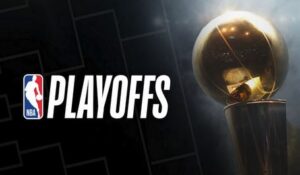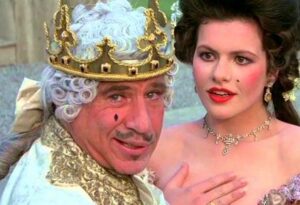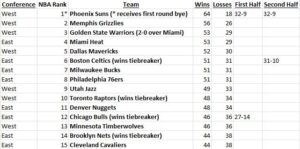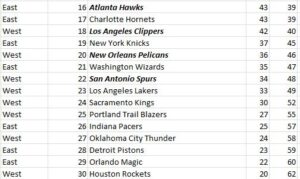Podcast: Play in new window | Download
Subscribe: RSS
Yes, I know that you’re a multi-billion dollar enterprise and certainly don’t need any advice from an old washed-up high school basketball player who has been a lifelong NBA fan.
That’s why the internet is so wonderful.
One person like me has the opportunity to put forward some ideas for change. Though it’s highly unlikely that anyone with the NBA will care what I have to say, my email is always available ([email protected]) if you care to reply.
After the football season ends in early February with the NFL’s Super Bowl game, basketball traditionally takes center stage to keep many sports fans interested during cold winter days.
By March, college basketball has its annual March Madness tournament. The 64 teams (OK, 68 these days) can play up to six increasingly suspenseful games (two per week) leading up to the championship finale. For one month, the college basketball post-season (men and women’s tournaments) has a positioned itself with a firm grasp on the nation’s television viewers.
Once March ends, it makes logical sense that the professional basketball league should begin a suspenseful playoff season, too. Though April does, indeed, bring the NBA’s regular season to a merciful close for nearly half of the teams, the NBA playoffs (as currently structured) then stretches over three calendar months (from mid-April, all of May, and into mid-June) in order to determine pro basketball’s champion.

If the NBA plays an 82-game regular season (more than double the number of games than played by the college basketball champion), why do the NBA playoffs need to take so long to determine the top team? Does it really take up to 100 games in a season (which is incredibly hard on your joints, by the way) for professional basketball to determine its winner?
The real answer is that it’s all about MONEY!
The 30 NBA teams really do need enough current revenues to cover their annual costs. With NBA teams paying a league minimum of $122 million (yes, that’s you San Antonio) to over $200 million (I see you, Golden State!) to its roster of players in team salaries this year, the NBA franchises need to generate a lot of revenue from national television, home arena tickets sales, local radio/television, merchandise, and assorted other revenue sources to pay the players and the team’s bills every season. The NBA’s largest television viewing audiences generally occur during its lengthy playoff season.
The desire for most NBA (or other professional sports franchise, for that matter) teams is to simply turn a profit every season and, effectively, tread water in hopes that the valuation of the team will continue to increase. You wish to avoid spending any cash out of your own savings account in any particular season while patiently watching the value of your asset/sports franchise grow and grow over time.
Did you know that the average NBA franchise is now worth over $2 billion? The real money comes when (or if, in the case of a long-time loser franchise such as the New York Knicks) the owner finally decides to sell the team and cash in.
The phrase “Buy low – Sell high” is quite literally the financial goal of every professional sports franchise owner.
Here’s a real life example. If our friend (Wile E. Investor) was smart enough to have purchased 1,000 shares of Amazon (symbol: AMZN) stock back in May, 1997 at $1.50 per share (actual price), today (25 years later) he would be able to sell the stock for $2,763 per share! Those 1,000 shares of stock (initial cost of $1,500) are now valued at $2,763,000.
When you’ve made such a windfall, how does anyone know when is the best time to sell? That depends on whether he finds a more valuable use for the money or, perhaps, felt like his investment value had peaked, or maybe (as in the case with at least one NBA franchise in New York) was feeling the wrath of thousands of angry fans simply tired of seeing their favorite team lose nearly every season.
You might ask, “What about those outlandish, ever-increasing players’ salaries being paid? Can’t the owners do anything to get those costs under control?” Sure, they can! The real question is, “Why should they?”
As long as television (which covets a young male-oriented target market) keeps upping the financial ante every decade and passes the costs along to you in the form of longer games and halftimes featuring even more commercials, then the NBA owner makes more revenue. In addition, the NBA team’s local fans will be asked to pay more money for already-overpriced tickets to watch games in person (we’re talking $30 for nosebleed upper-deck seats at most arenas to more than $1,000 to watch a game in the first ten rows – where you can hear the players bicker and curse up close and personal), then the owner has no incentive to reduce costs as long as his annual income statement shows a small profit every season.
As with most every business, the value to be paid by a prospective owner has a lot to do with the current cash flows of the business. A multiple of the cash which comes in and out of the business annually is generally used to determine the intrinsic value of the business being purchased.
In the case of the NBA (and every other sports franchise), the higher the annual costs needed to operate the team (such as increasing player salaries), the higher the value of the team. If players salaries went down by 50%, guess what would happen to the value of your average sports franchise? You guessed correctly!
Today’s professional players and owners are both quietly winking at each other and getting richer. Neither is motivated to pop this bubble. It will take a decrease in demand (from television revenue and local ticket sales) to sink the value of sports franchises. .
You see, most NBA franchises really don’t care if they show a lot of profit from year to year to help keep their taxes down. The big payday comes down the line when (or if) they sell the team.
To an NBA owner, the team franchise has become a nifty investment vehicle which also brings the owner local adoration. In some cases, the team owner receives the halo effect of positive goodwill from the local citizenry to support other hometown business ventures (such as car dealerships).
Yes, it’s good to be the King!

You may have noticed that every few sports franchises are being sold year-to-year. That tells me that most sports franchise owners are happy to keep on waiting and watching their franchise values increase from year to year. You would do exactly the same thing!
This finally brings us back to the NBA playoffs.
I have a few simple changes which I am proposing to make the NBA’s regular season more entertaining from start to finish and to shorten the NBA playoffs.

- Let’s break the NBA season into two 41-game halves (with the NBA All-Star weekend coming during that same week). The first half winner in the Eastern Conference and Western Conference will clinch a playoff berth – regardless of how they fare during the second half of the regular season. This assures that fan interest will be generated earlier in the basketball season as a few upstart teams might race out of the gate to capture the first half conference title.
- The second half of the NBA season is played and, like the first half, a second half champion for the Eastern and Western conference is determined and earns an automatic playoff teams. If the same team wins both the first and second half of the NBA season, they will receive a “bye” in Round 1. That’s what would happen for the Phoenix Suns this year. They would have received a “bye” in Round 1. As a result, only 15 teams (total) would have been allowed to make the NBA playoffs in 2022 due to the Phoenix Round 1 bye.
- Ditch the current “Play-in” format (giving 9th and 10th place teams a chance to qualify for the playoffs) immediately. If 82 regular season games aren’t enough to show that your team is playoff worthy, what is? Good riddance.
- The 16-team NBA playoffs (assuming there are no repeat first and second half Conference winners) will be seeded without consideration to conferences and based on each team’s full 82-game regular season record. Any ties will be broken based on head-to-head competition. If the teams are still tied, the team which has the best overall home record receives preference. If a tie remains, a coin flip determines the winner(s).
- The Automatic Qualifiers (the first half and second half winners from the Eastern and Western conferences) will be seeded based on their 82-game regular season record.
- Round 1 playoffs (from 16 teams to 8) – The top seeded teams face the lowest available seeds in a two games out of three format played in one week. The top seeded team hosts Games #1 and, if needed, #3.
- Round 2 playoffs (8 teams to 4) – Same format as above (best two out of three games)
- Round 3 playoffs (4 teams to 2) – Best three out of five games with at least one night off between games. The top seeded team hosts Games #1, #2, and, if needed, #5.
- NBA Finals (2 teams to 1 champion) – Same format as Round 3 (best three out of five games).
- NBA Draft Lottery rule change – To discourage the weakest NBA teams from “tanking” (losing more games on purpose to improve their draft lottery chances), the teams which fail to make the playoffs each season will each be given an equal weighting (i.e. – just one lottery ball apiece). The current “weighting” method simply hasn’t worked well enough to motivate the weakest franchises. More excitement will be generated if we give all fourteen teams the same chance to get lucky and rebuild their teams. Having the #1 draft pick doesn’t necessarily assure that a franchise will select the best player that year. Remember names like Markelle Fultz (2017), Ben “Soft Serve” Simmons (2016), Anthony Bennett (2013), and Greg Oden (2007)? Mistakes happen.
Yes, this new NBA playoff format eliminates the current slothful “Best of Seven” format in each round. This simple change would reduce the length of time needed for the NBA playoffs and would end the season in May (instead of June). The compressed playoff schedule should convey a greater sense of urgency to the players and capture more interest from the fans.
Below is my proposed SwampSwamiSports.com revised NBA playoff roster for 2022. This season, only 15 teams would have qualified for the playoffs as the Phoenix Suns (which had the best record in the NBA’s Western Conference in both the first and second half with an identical 32-9 record) would have earned a first round bye. In the Eastern Conference, the first half champ was Chicago (27-15) while the second half winner Boston Celtics went a nifty 31-10.

OUT OF THE PLAYOFFS

With my proposed playoff changes, the Cleveland Cavaliers (by virtue of a 44-38 regular season record) would have qualified for the final playoff spot at #15. However, the Atlanta Hawks, New Orleans Pelicans, Los Angeles Clippers, and San Antonio Spurs would have stayed home for the post-season this year.
There you go, NBA! I hope that you will give these ideas a little thought.
Yours truly,
SwampSwami

